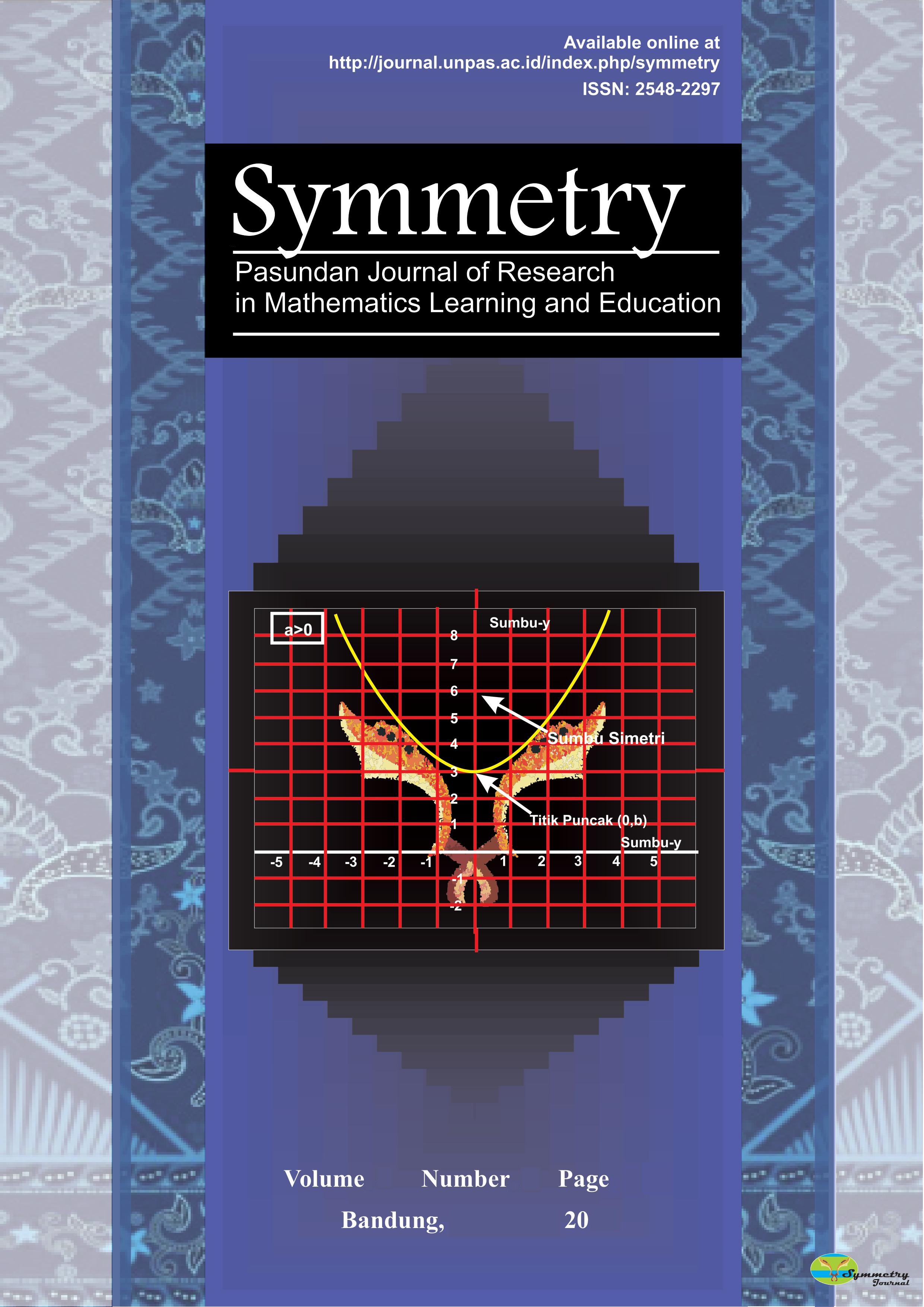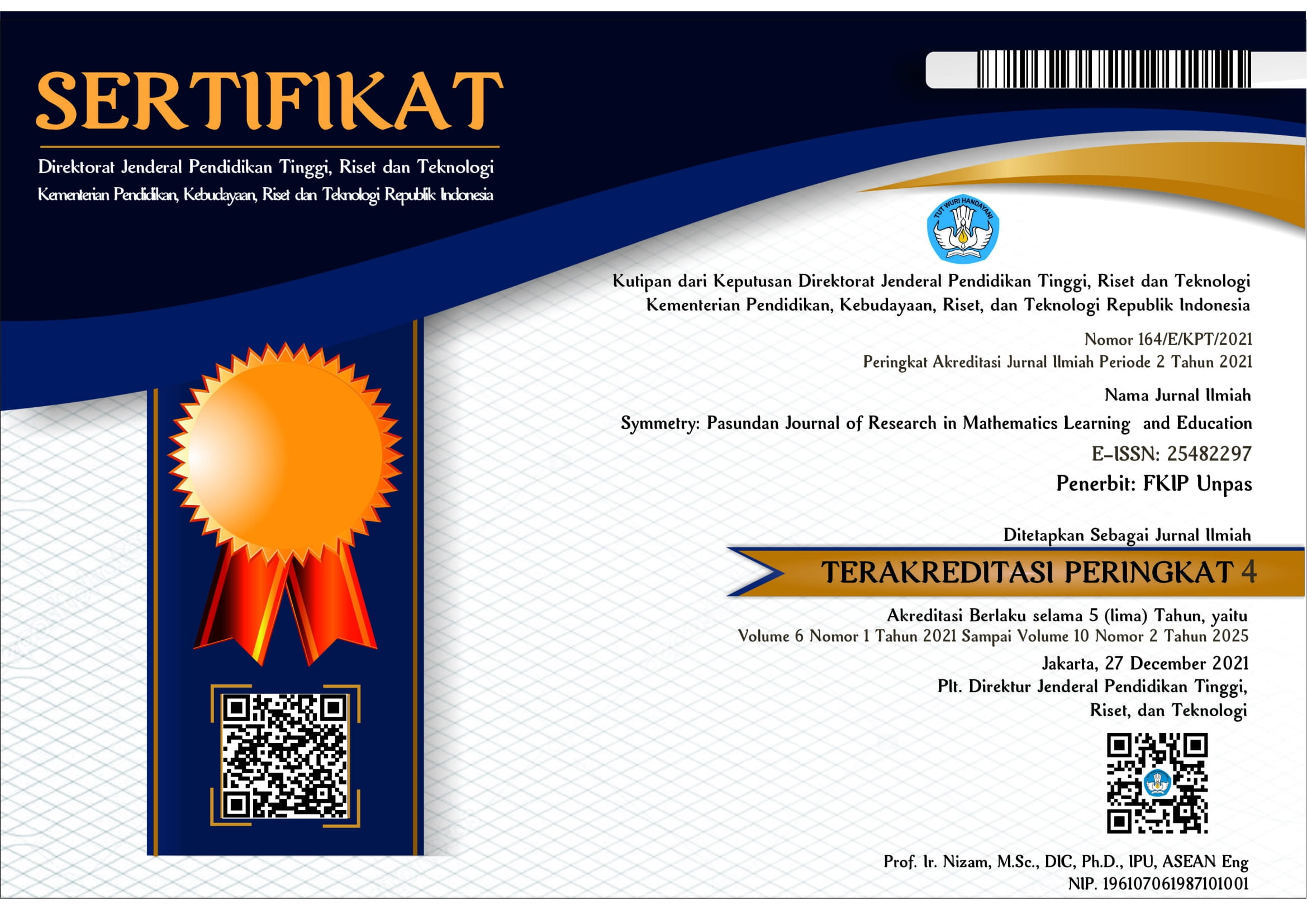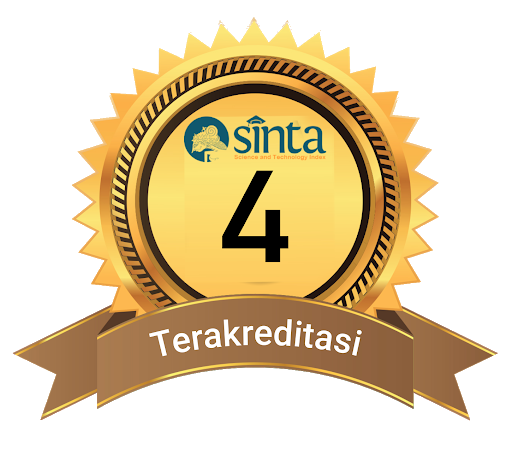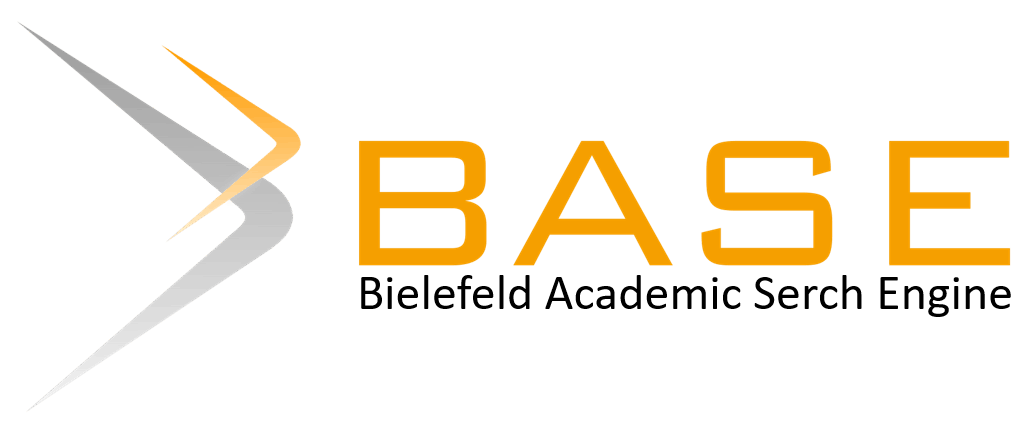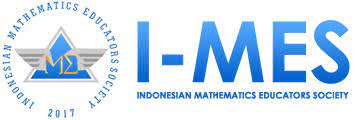Indonesian Students’ Mathematical Literacy Based on Self-Efficacy: Systematic Literature Review.
DOI:
https://doi.org/10.23969/symmetry.v7i2.6378Keywords:
Mathematical Literacy, Self-Efficacy, SLRAbstract
The main purpose of this study is to describe the results of students’ mathematical literacy based on self-efficacy. The method used in this study was Systematic Literature Review (SLR). The total sample was 17 articles of students’ mathematical literacy based on self-efficacy. The samples were articles indexed in SINTA, published in 2018 until September 2022 and located in Indonesia. The description in this study will be reviewed based on the journal indexes, year of publication, methods used, study level, sample size, research locations Through the SLR, it was obtained that in the past five years, most of the articles were published in SINTA 4, the most publications of students’ mathematical literacy based on self-efficacy happened in 2022, mix method became the most method used in this study, students’ in junior high school was dominantly used as the sample of this research, many researchers used more than or equal to 30 samples, and its research was widely conducted in Java
Downloads
References
Aisyah, A., & Juandi, D. (2022). The description of Indonesian student mathematics literacy in the last decade. International Journal of Trends in Mathematics Education Research, 5(1), 105–110. https://doi.org/10.33122/ijtmer.v5i1.114
Ananda, E. R., & Wandini, R. R. (2022a). Analisis Kemampuan Literasi Matematika Siswa Ditinjau dari Self Efficacy Siswa. Jurnal Obsesi : Jurnal Pendidikan Anak Usia Dini, 6(5), 5113–5126. https://doi.org/10.31004/obsesi.v6i5.2659
Ananda, E. R., & Wandini, R. R. (2022b). Analisis Kemampuan Literasi Matematika Siswa Ditinjau dari Self Efficacy Siswa. Jurnal Obsesi : Jurnal Pendidikan Anak Usia Dini, 6(5), 5113–5126. https://doi.org/10.31004/obsesi.v6i5.2659
Annisa Indrawati, F., Wardono, W., & Junaedi, I. (2022). Unnes Journal of Mathematics Education Research Mathematics Literacy Ability in Terms Of Self Efficacy in Cooperative Learning Type of Group Investigation Model With Humanism Approach Assisted by Schoology. http://journal.unnes.ac.id/sju/index.php/ujmer
Ariati, C., & Juandi, D. (2022). Kemampuan Penalaran Matematis: Systematic Literature Review. LEMMA: Letters Of Mathematics Education, 8(2), 61–75.
Byrne, J., & Humble, Á. M. (2007). An Introduction to Mixed Method Research.
Faozi, R., Wardono, W., Haryani, S., & al Miftah Sindangjaya, Mt. (2020). Mathematical Literacy Ability Reviewed From Self-Efficacy In Realistic Mathematics Education Approach. Journal of Primary Education, 9(4), 353–363. https://journal.unnes.ac.id/sju/index.php/jpe
Istiqomah, P., Kamid, K., & Hasibuan, M. H. E. (2021). Pengaruh Model Realistic Mathematics Education Terhadap Kemampuan Literasi Matematika Ditinjau dari Self Efficacy Siswa. AKSIOMA: Jurnal Program Studi Pendidikan Matematika, 10(4), 2775. https://doi.org/10.24127/ajpm.v10i4.4334
Juandi, D. (2021). Heterogeneity of problem-based learning outcomes for improving mathematical competence: A systematic literature review. Journal of Physics: Conference Series, 1722(1). https://doi.org/10.1088/1742-6596/1722/1/012108
Khairunnisa, A., Gozali, S. M., & Juandi, D. (2022). Systematic Literature Review: Kemampuan Pemahaman Matematis Siswa dalam Menyelesaikan Masalah Matematika. 06(02), 1846–1856.
Lame, G. (2019). Systematic literature reviews: An introduction. Proceedings of the International Conference on Engineering Design, ICED, 2019-August, 1633–1642. https://doi.org/10.1017/dsi.2019.169
Lestari, I. S., Zaenuri, Z., & Mulyono, M. (2022). Literasi Matematika Ditinjau dari Self Efficacy dengan Menggunakan Problem Solving Learning Model dengan Strategi Scaffolding. Jurnal Inovasi Sekolah Dasar, 9(1). https://doi.org/10.36706/jisd.v9i1.17091
Liu, X., Koirala, H., & Liu Hari Koirala, X. (2009). The Effect of Mathematics Self-Efficacy on Mathematics Achievement of High School Students The Effect of Mathematics Self-Efficacy on Mathematics Achievement of High School Students The Effect of Mathematics Self-Efficacy on Mathematics Achievement of High School. In The Effect of Mathematics Self-Efficacy on Mathematics Achievement of High School Students (Vol. 30). https://opencommons.uconn.edu/nera_2009/30
Mahdiansyah, & Rahmawati. (2014). Mathematical Literacy ff Students At Secondary Education Level: An Analysis Using International Test Design with Indonesian Context. In Jurnal Pendidikan dan Kebudayaan (Vol. 20).
Mahmudah, W. (2018). Analisis Kesalahan Siswa dalam Menyelesaikan Soal Matematika Bertipe Hots Berdasar Teori Newman. Jurnal UJMC, 4, 49–56.
Martalyna, W., Asikin, M., & Negeri, S. (2018). 2018) 54-60 Wihdati Martalyna, Isnarto. Mohammad Asikin / Unnes Journal of Mathematics Education Research, 7(1), 54–60. http://journal.unnes.ac.id/sju/index.php/ujmer
Masfufah, R., & Afriansyah, E. A. (2021). Mosharafa: Jurnal Pendidikan Matematika Analisis Kemampuan Literasi Matematis Siswa melalui Soal PISA. 10(2). http://journal.institutpendidikan.ac.id/index.php/mosharafa
Masjaya, M., Waluya, B., & Wardono, W. (n.d.). Unnes Journal of Mathematics Education Research Mathematics Literacy Based on Students’ Self-efficacy By DAPIC Problem-Solving Realistic Approach With EDMODO-assisted. Unnes Journal of Mathematics Education Research, 11(1), 2022–2056. http://journal.unnes.ac.id/sju/index.php/ujmer
Nugroho, H. A., & Hidayah, I. (2020). Mathematical Literacy in Discovery Learning with Scaffolding Strategy Reviewed from Self Efficacy. Unnes Journal of Mathematics Education Research, 9(1), 44-51.
Oecd. (2017). PISA for Development Assessment and Analytical Framework READING, MATHEMATICS AND SCIENCE PISA PRELIMINARY VERSION. www.oecd.org/about/publishing/corrigenda.htm.
OECD. (2019). The Programme for International Student.
Pertiwi, M., Suhendra, S., & Juandi, D. (2022). Mathematical Literacy Ability of Junior High School Students in Terms of Self-Efficacy. SJME (Supremum Journal of Mathematics Education), 6(2), 171–180. https://doi.org/10.35706/sjme.v6i2.6547
Prabawati, M. N., Muslim, S. R., & Mansyur, Z. (2021). Analisis Kesalahan Siswa Sekolah Menengah Pertama di Kota Tasikmalaya dalam Menyelesaikan Soal Literasi Matematis pada Materi SPLDV. Jurnal Penelitian Pendidikan Dan Pengajaran Matematika, 7(2), 117–128. https://doi.org/10.37058/jp3m.v7i2.3661
Pradinar, A. P., Sulistyawati, I., & Yustitia, V. (2021). Seminar Nasional Hasil Riset dan Pengabdian Ke-III (SNHRP-III 2021) LITERASI MATEMATIKA SISWA SEKOLAH DASAR DENGAN SELF-EFFICACY TINGGI: STUDI KASUS.
Putri, R. I. I., & Zulkardi, Z. (2018). Higher-order thinking skill problem on data representation in primary school: A case study. Journal of Physics: Conference Series, 948(1). https://doi.org/10.1088/1742-6596/948/1/012056
Rifai, & Wutsqa, D. U. (2017). Mathematical Literacy of State Junior Secondary School Students in Bantul Regency. Jurnal Pendidikan Matematika Dan Sains, 2, 152–162. https://doi.org/10.21831/jpms.v4i1.10111
Rijanto, T. (2012). The Impact of Methods And Sample Size to the Score Variance of Equating Result.
Sari, R. H. N., & Wijaya, A. (2017). Mathematical literacy of senior high school students in Yogyakarta. Jurnal Riset Pendidikan Matematika, 4(1), 100–107. https://doi.org/10.21831/jrpm.v4i1.10649
Selan, M., Daniel, F., Babys, U., Studi Pendidikan Matematika, P., & Soe, S. (2020). Analisis kemampuan literasi matematis siswa dalam menyelesaikan soal pisa konten change and relationship (Vol. 11, Issue 2).
Setiani, C., Waluya, S. B., & Wardono. (2018). Analysis of mathematical literacy ability based on self-efficacy in model eliciting activities using metaphorical thinking approach. Journal of Physics: Conference Series, 983(1). https://doi.org/10.1088/1742-6596/983/1/012139
Shonfeld, M., Aharony, N., & Nadel-Kritz, N. (2022). Teachers’ perceived information literacy self-efficacy. Journal of Librarianship and Information Science, 54(3), 494–507. https://doi.org/10.1177/09610006211026950
Simarmata, Y., Wedyawati, N., & Hutagaol, S. R. (2020). Analisis Literasi Matematika Pada Penyelesaian Soal Cerita Siswa Kelas V Sekolah Dasar.
Spisak, J. R. (2022). Information literacy self-efficacy versus performance: Secondary students. Journal of Librarianship and Information Science. https://doi.org/10.1177/09610006221081847
Sulistiya, S., & Rachmani Dewi, N. (2021). Kemampuan Literasi Matematika Ditinjau Dari Self-Efficacy pada Materi Trigonometri Siswa Kelas X (Vol. 7).
Taofik, A. I., & Juandi, D. (2022). Description of Mathematical Representation Ability Through HOTS-Oriented Learning Model: a Systematic Literature Review. Jurnal Analisa, 8(1), 46–56. https://doi.org/10.15575/ja.v8i1.17915
Utomo, M. F. W, Pujiastuti, H., & Mutaqin, A. (2020). Analisis Kemampuan Literasi Matematika Ditinjau dari Gaya Kognitif Siswa. Kreano, Jurnal Matematika Kreatif-Inovatif, 11(2), 185–193. https://doi.org/10.15294/kreano.v11i2.25569
Widianti, W., Hidayati, N., Singaperbangsa Karawang, U., Ronggo Waluyo, J. H., Telukjambe Timur, K., & Barat, J. (2021). Analisis Kemampuan Literasi Matematis Siswa SMP pada Materi Segitiga dan Segiempat. Jurnal Pembelajaran Matematika Inovatif, 4(1). https://doi.org/10.22460/jpmi.v4i1.27-38
Widiastuti, A., Kebijakan, A., Perencanaan, B., Daerah, P., & Banten, P. (2021). Dampak Pandemi Covid-19 Terhadap Pertumbuhan Ekonomi di Pulau Jawa. 11(1). http://jurnal.untirta.ac.id/index.php/Ekonomi-Qu
Wijaya, A. (2016). Students’ Information Literacy: A Perspective from Mathematical Literacy. Journal on Mathematics Education, 7(2), 73–82.
Yeo, G. B., & Neal, A. (2013). Revisiting the Functional Properties of Self-Efficacy: A Dynamic Perspective. In Journal of Management (Vol. 39, Issue 6, pp. 1385–1396). https://doi.org/10.1177/0149206313490027
Yuniati, I., Juhana, A., Loka Son, A., & Gunadi, F. (2020). Bagaimanakah Literasi Matematika Siswa Sekolah Menengah Pertama pada Materi Relasi Dan Fungsi?: Exploratory Case Study. Jurnal Pendidikan Matematika, 2(1).
Downloads
Published
Issue
Section
License
Copyright (c) 2022 Symmetry: Pasundan Journal of Research in Mathematics Learning and Education

This work is licensed under a Creative Commons Attribution 4.0 International License.
Hak Cipta sepenuhnya ditangan jurnal.

